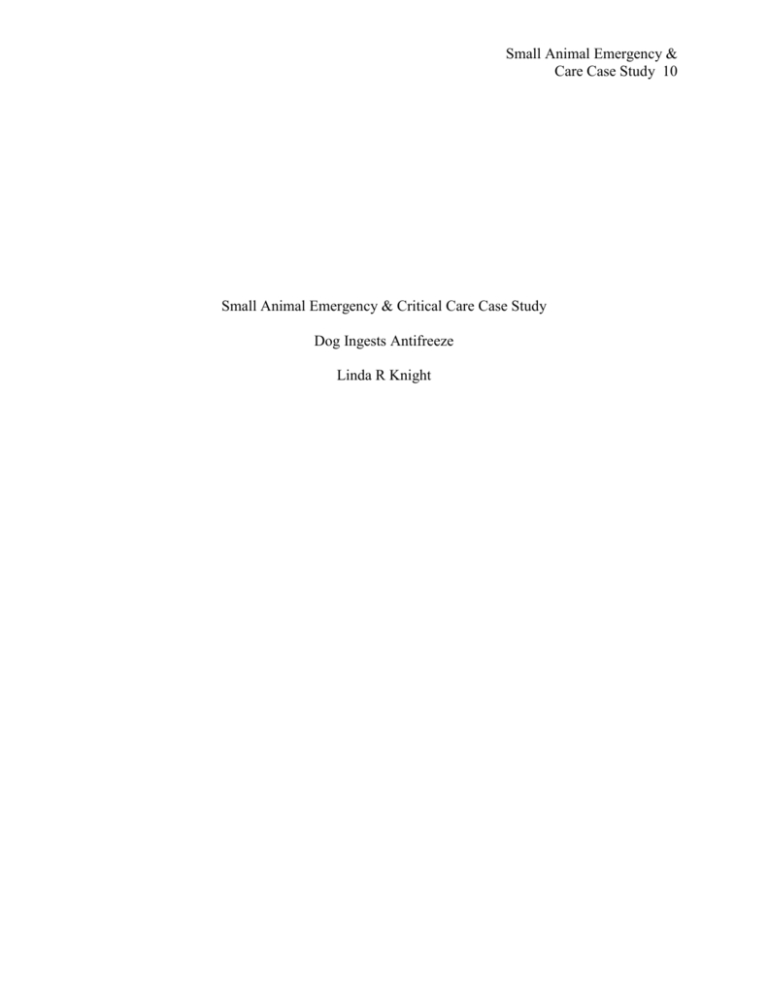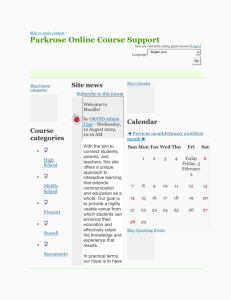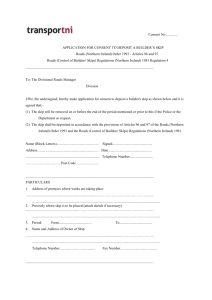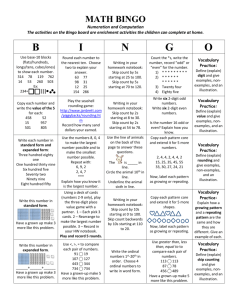File - Linda Rojas Knight
advertisement

Small Animal Emergency & Care Case Study 10 Small Animal Emergency & Critical Care Case Study Dog Ingests Antifreeze Linda R Knight Small Animal Emergency & Care Case Study 10 History: Skip is a 2 year MN Beagle, who presented today for possibly ingesting antifreeze. Ethylene glycol is the key ingredient in most antifreeze brands, it has a sweet flavor. Its alluring smell and taste frequently tempt animals to drink the extremely poisonous substance. It merely takes a few tablespoons of highly toxic antifreeze to extremely threaten an animal's life. There are three stages of poisoning that can been seen with ethylene glycol (Pet Poison Helpline, 2015) Stage 1: 30 minutes to 12 hours, walking drunk, drooling, vomiting, Seizuring, and excessive thirst, and urination may be seen Stage 2: 12-24 hours may seen to have resolved, but in fact more severe internal injury is occurring. Stage 3: In cats, this stage occurs 12-24 hours after ethylene glycol exposure. In dogs, this stage occurs 36-72 hours post-ingestion. For the duration of this stage, severe acute kidney failure is occurring. Signs of inappetance, lethargy, drooling, halitosis (secondary to kidney failure), coma, depression, vomiting, and seizures (Pet Poison Helpline, 2015). Skip should be bathed in a mild hand dishwashing detergent and repeated if necessary, and it’s recommended that Skip should be bought into the clinic. Skip has no known health concerns, is current on vaccines, and lives an active lifestyle. Physical Examination: Weight: 33 kg Temperature: 101.5*F P: 88 bpm R: 64 rpm Small Animal Emergency & Care Case Study 10 Upon examination, Skip is normal in all parameters and is acting fine. Skip was ambulatory on all four limbs, Skip appeared well-muscled and symmetrical. His hair was clean, mucous membranes were pink, capillary refill time of less < 2 seconds, teeth were clean, both ears were clean from debris and no inflammation was noted, both eye were clean and no discharged was noted. Auscultation of the heart revealed a normal sinus rhythm, murmur was not assaulted and femoral pulses were synchronous with the heart, no organomegaly were noted during palpation of the abdomen. The rest of the exam was unremarkable. Diagnostic Tests & Results: The veterinarian wants to induce vomiting in Skip and decides to use apomorphine conjunctively. Apomorphine is an emetic of choice for dogs, and it usually takes about 15 minutes. It vital that we monitor Skip for hypersensitivity or any allergic reaction to the drug, sometimes it may cause excitement, restlessness, nervous system depress, and respiratory depression can occur. Although conjunctival administration is usually effective, it is not as fast or reliable as the injectable route, after treatment it’s critical to rinse the conjunctival sac with saline, decreasing residual drug absorption. Vomiting should not be induced if the animals has ingested acid, caustic agents, or petroleum distillates (Forney, 2004-2013) Skip will be placed under heavy sedation for a procedure known as gastric lavage. This procedure allows us to evacuate the stomach contents to prevent absorption, it is relatively safe, simple, and effective and is approximately 20-30 minutes. Materials required, stomach tube (18F rubber catheter), mouth gag (i.e. roll of tape), appropriate size cuffed endotracheal tube, suction device, water soluble lubricant, syringe with 5-10ml water/saline for checking positon of tube, syringe or funnel for administering lavage fluid. Skip will be intubated with an endotracheal tube and cuffed to prevent aspiration of stomach contents as well as aspiration Small Animal Emergency & Care Case Study 10 pneumonia. We placed the stomach tube into the stomach through the esophagus, instilled warm water through a funnel (about 5-10ml/kg at a time), placed a bucket at floor level to act as a drain, flushed water into the tube until returning fluid is clear, then flush in fluid to distend the stomach and then aspirate using a syringe and repeat about 10 times, palpate abdomen during process to avoid over distension of the stomach (Harkin, 2014). A dose of activated charcoal (AC) will be administered. AC is used to increase surface area and allow many binding sites for adsorption of toxic agents. A few areas should be monitored such as, urine pH, azotemia, oliguria, renal failure, CNS depression, stupor, coma, ataxic and knuckling. Treatment: Skip received 4-methylpyazole at four different times throughout the night and received continuous IV fluids. The veterinarian orders the following dosage regime: Immediate 11am 1-10-12 2.724ml 11pm same day 1-10-12 2.043ml 11am following day 1-11-12 2.043ml 11pm same day 1-12-12 .681ml IV Drip 21.28ml/hr Instructions: It’s important to know that other foods that can be toxic to pets are listed below: Avocado, Raisins Currants, Cooked Bones, Walnuts, Macadamias, Onions, Garlic, Grapes, Mushrooms, Caffeine, Xylitol, and Chocolate. Not only are many household foods are dangerous to animals, but you should also be aware of household products such as, acids, bleach, pine-sol, detergents, fluoride, gorilla glue, hand sanitize, potpourri, and mothballs. Small Animal Emergency & Care Case Study 10 Rhododendrons can have serious effect on pets, if they eat even a few leaves it can result in vomiting, diarrhea and excessive drooling, without immediate attention, the pet could fall into a coma and possibly die. A few other plants that can be fatal if ingested are, lilies, cyclamen, kalanchoe, oleander, sago palm. However, a few plants that may just cause irritation are bittersweet, wisteria, autumn crocus, English holly, and buckeye. Please contact us immediately if Skip continues to have any issues. Thank you for entrusting us with Skips care. References: Harkin, Ken DVM, (2014) Gastric Lavage, Vetstream, Retrieved April 2, 2015 https://www.vetstream.com/canis/Content/Technique/teq00664 Pet Poison Helpline, Retrieved April 2, 2015 http://www.petpoisonhelpline.com/poison/antifreeze/ Forney, Barbara, DVM, (2004-2013) Retrieved April 2, 2015 http://www.wedgewoodpetrx.com/learning-center/medication-information-for-pet-andhorse-owners/apomorphine-for-dogs.html#_Toc239745957 Antifreeze Is a Sweet but Deadly Poison for Pets (2015) Retrieved April 2, 2015 http://www.humanesociety.org/animals/resources/tips/antifreeze.html Richardson, Jill, DVM. ASPCA Tips to Manage a Poison Emergency, Retrieved April 2, 2015, http://www.vspn.org/Library/misc/VSPN_M01158.htm Loftin, Erika DVM, DACVECC, (2012) Toxicities in the ER. Retrieved April 2, 2015 http://www.dovelewis.org/pdf/events/Erika_toxins.pdf



